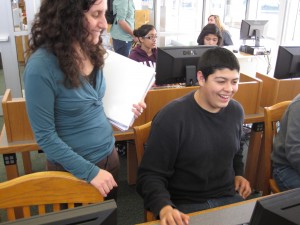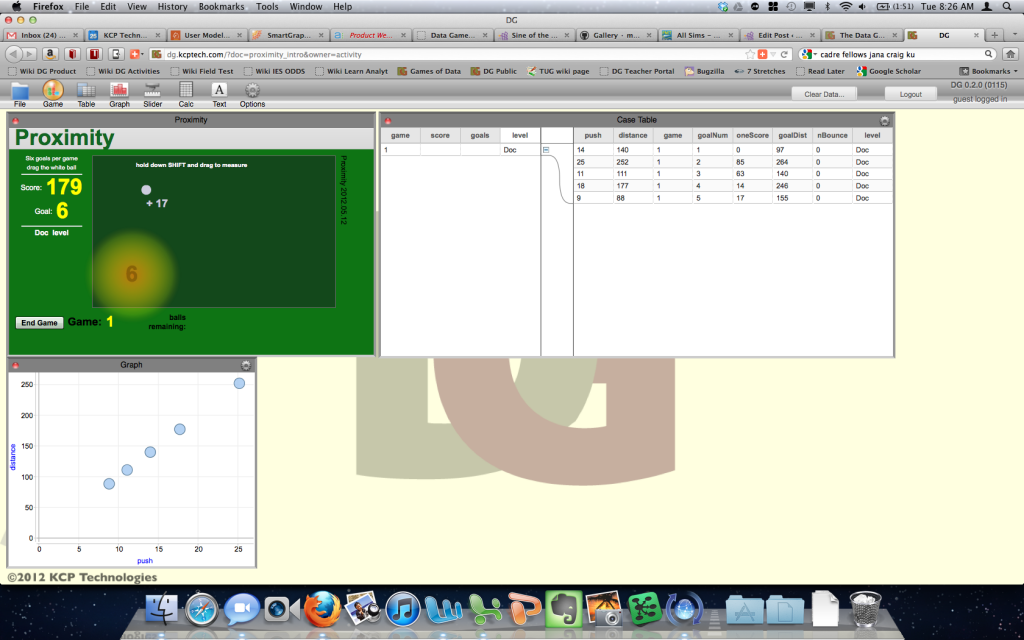I had the privilege this year of participating in the CADRE Fellows Program of NSF’s Community for Advancing Discovery Research in Education, and met a number of colleagues in the program whose projects, like our Data Games project, are exploring the classroom benefits of computer-game- or simulation-based-learning. (In this post, I’ll refer to technology-oriented games and simulations simply as “games,” for brevity’s sake.) Some of these exciting projects include: PhET, Math Snacks, and Evidence Games. As we discussed our work, an interesting common issue surfaced regarding how each of our projects envisions the appropriate role for the teacher in facilitating our game activities. A small group of Fellows offered a panel presentation at the CADRE conference in Washington, DC a couple of weeks ago on this topic, and I’ll share a few of our key ideas here.

First of all, no one in these projects is aiming to design teacher-proof materials, as we all think the teacher plays a crucial role in using technology tools successfully with students. Some key tasks for the teacher in classroom learning with computer games:
- Plan when in the course curriculum the game best fits and aligns with learning goals
- Provide links for students connecting game activity with previous course skills
- Establish lesson plan and structures (e.g., competition vs. cooperation) for game activity
- Use knowledge of game, technology, learning goals, and individual students to provide personalized support during gameplay
- Facilitate follow-up questions, discussion, and activities to promote mastery of learning goals and deeper understandings for all students
These tasks look similar to those for most lessons, but there are special challenges and other considerations in the teacher roles when using games. First of all, some teachers may envision their role with the belief that with a computer game in front of them, the students will be so fully engaged that the teacher can take a hands-off approach. There is certainly ample evidence for greater potential for student motivation and learning with a game activity than with many more traditional textbook-based activities, but unless the teacher takes an active role as described above, the learning potential for that game will most likely not be fully realized.
Some teachers used to a more teacher-centered classroom, on the other hand, may not readily turn over as much of the learning to the student, software, and supporting activity materials as desirable, and may intervene and direct student actions too much. We’ve designed the Data Games and supporting activities from a constructivist perspective, believing that student learning will increase the more they solve problems and figure things out for themselves. Teachers should use their understandings of their individual students and provide them nudging and guidance only as needed to ensure progress in a timely way.
This leads us to a final consideration we’ve wrestled with in the design of Data Games, regarding the 4th bullet above: how much coaching and prompting is it appropriate for the teacher to do, and how much should the software provide? We’ve decided it’s beneficial to enable the software to give a great deal of the targeted feedback and prompting to students so they don’t get stuck when playing, rather than relying entirely on the teacher to provide this support for all students in class. Some of this can be accomplished up front in the user interface, while in other areas monitoring individuals’ progress and offering prompts has seemed warranted.

In the Proximity game, for example, we’ve incorporated a timer, so that if in the last 30 seconds the player hasn’t taken the key action of measuring the distance from the ball to the target, then a prompt appears on the screen reminding them how to do that (see screenshot above). It is tricky to decide how the software can balance providing this type of scaffolding with maintaining an approach that is not overly directive. But we don’t want students to get stuck, and we don’t want to burden teachers with the unrealistic expectation that they can always be there at the right time with the right intervention to support each student’s progress in the game. We’ve decided since our software is tracking individual progress, wherever feasible it is the most efficient source of targeted intervention.
In future iterations of our Data Games, we’ll continue aiming for the right balance between the teacher and game software roles for providing coaching support; and each teacher will need to draw on his/her professional wisdom in deciding the right type and amount of support to offer students as well.